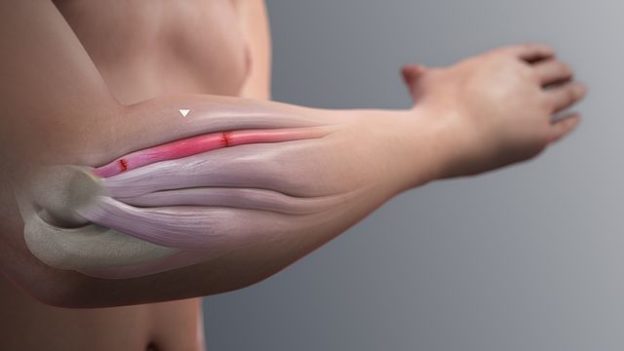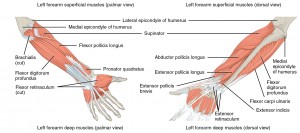Image :
“Inflammation of a forearm extensor muscle” by scientificanimations.com. License:
CC BY-SA 4.0
Flexors of the Elbow
The flexors of the elbow include the brachialis muscle, the brachioradialis muscle, and the biceps brachii muscle.
| Muscle | Origin | Insertion | Nerve supply | Function |
| Brachioradialis | Proximal two-thirds of lateral supracondylar ridge | Lateral surface of distal radius and pre-styloid process | Radial nerve (C6) | Weak flexor of the elbow, strong flexor when forearm mid-pronated |
| Brachialis | Anterior aspect of the humerus lateral to the deltoid tuberosity | Ulnar tuberosity | Musculocutaneous nerve (C5-C7) | Flexes the elbow and assists with supination. |
| Biceps brachii | Short head – coracoid process
Long head – supraglenoid tubercle
| Tuberosity of the radius | Musculocutaneous nerve (C5-C6) | Supinates the forearm and assists with elbow flexion |
| Extensor carpi radialis longus | Lateral supracondylar ridge | Dorsal aspect of 2nd metacarpal | Radial nerve (C6, C7) | Extend and abduct wrist |
| Extensor carpi radialis brevis | Lateral epicondyle (common extensor origin) | Dorsal aspect of the 3rd metacarpal | Deep branch of the radial nerve (C7) |
Extensors of the Elbow
| Triceps brachii | Long head – infraglenoid tubercle
Lateral and medial heads – posterior humerus
| Olecranon | Radial nerve (C6 – C8) | Extends the elbow |
Flexors of the Arm
Divided into two groups – the common flexors and the deep flexors.
Common flexors
| Muscle | Origin | Insertion | Nerve supply | Function |
| Pronator teres | Ulnar head: coronoid process of ulna
Humeral head: medial epicondyle | Middle of lateral surface of radius | Median nerve (C7) | Pronates and flexes the forearm |
| Flexor carpi radialis | Medial epicondyle of humerus | Base of 2nd metacarpal | Flexes and abducts hand at wrist |
| Palmaris longus | Flexor retinaculum and palmar aponeurosis | Flexes hand at wrist and tenses palmar aponeurosis |
| Flexor carpi ulnaris | Olecranon and posterior ulna | Pisiform, hook of hamate, 5th metacarpal | Ulnar nerve (C8) | Flexes and adducts hand at wrist |
Deep flexors
| Muscle | Origin | Insertion | Nerve supply | Function |
| Flexor digitorum profundus | Proximal surfaces of medial and anterior surfaces of ulna and interosseous membrane | Medial four digits distal phalanges | Lateral muscle bellies to digits 2 and 3: Median nerve (C7, C8, T1)
Medial muscle bellies to digits 4 and 5: Ulnar nerve (T1) | Flexes hand at wrist joint
Flexes distal interphalangeal joint |
| Flexor pollicis longus | Anterior surface of radius and interosseous membrane | Distal phalanx of first digits | Anterior interosseous nerve (branch of median) (C8) | Flexes wrist
Flexes interphalangeal and metacarpophalangeal joints of first digits |
| Pronator quadratus | Distal quarter of ulna | Distal quarter of radius | Pronates forearm |
Extensors of the Arm
Also divided into two groups – the common extensors and the deep extensors.
Image: “Muscles That Move the Forearm” by Phil Schatz. License:
CC BY 4.0
Common extensors
| Muscle | Origin | Insertion | Nerve supply | Function |
| Extensor carpi radialis (longus and brevis) | | | | |
| Extensor digitorum | Lateral epicondyle (common extensor origin) | Extensor expansion of medial four digits | Posterior interosseous nerve (C7; from deep radal nerve) | Extend wrist
Extend medial four digits at metacarpophalangeal and interphalangeal joints (fifth digit for EDM) |
| Extensor digiti minimi | Extensor expansion of fifth digit |
| Extensor carpi ulnaris | Lateral epicondyle and posterior surface of ulna | Dorsal aspect of fifth metacarpal | Extends and adducts wrist |
Deep extensors
| Muscles | Origin | Insertion | Nerve supply | Function |
| Supinator | Lateral epicondyle of humerus, supinator fossa and proximal ulna | Posterior, lateral and anterior surfaces of proximal radius | Deep branch of radial nerve (C8) | Supination of forearm |
| Abductor pollicis longus | Posterior surface of radius and ulna and interosseous membrane | Metacarpal of first digit | Posterior interosseous nerve (C7 and C8) from deep radial nerve | Extends wrist
Abducts thumb and extends it at carpometacarpal joint |
| Extensor pollicis longus | Posterior surface of ulna and interosseous membrane | Dorsal surface of distal phalanx of first digit | Extends wrist
Extends distal (EPL)/ proximal (EPB) phalanx of thumb at interphalangeal joint
Extends metacarpophangeal and carpometacarpal joints |
| Extensor pollicis brevis | Posterior surface of radius and interosseous membrane | Dorsal surface of proximal phalanx of first digit |
| Extensor indicis | Posterior surface of the ulna | Extensor expansion of 2ndfinger | Posterior interosseous nerve (C7 and C8) from deep radial nerve | Extends 2nd finger and assists with hand extension |
Review Questions
Solutions can be found below the references.
1. Which of the following muscles does not have any flexion capacity in the elbow or forearm?
- Pronator teres muscle
- Extensor carpi radialis longus muscle
- Brachialis muscle
- Brachioradialis muscle
- Anconeus muscle
2. What nerve innervates the flexor carpi radialis muscle?
- Axillary nerve
- Radial nerve
- Median nerve
- Ulnar nerve
- Musculocutaneous nerve
3. Which of the following muscles does not belong to the group of the dorsal ulnar and palmar-dorsal abductors?
- Extensor carpi ulnaris muscle
- Extensor digiti minimi muscle
- Extensor digitorum muscle
- Extensor indicis muscle
- Flexor carpi ulnaris muscle


Comentários
Enviar um comentário